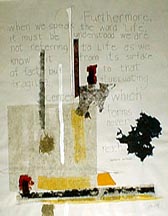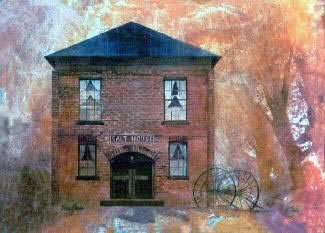 A Country Rag Country Reckoning
A Country Rag Country Reckoning
"The Essential Woman: Using Herbs"
Raised in Columbia TN, Heather Jett has a BA and is a thesis-short of her masters in English Literature. She serves as Operations Manager for Historic Jonesborough Foundation and enjoys creating original pottery.
Graphic: Margaret Gregg, oil on canvas, Mill 'N Creek Studio Gallery, Limestone, TN"Furthermore, when we speak the word 'Life' it must be understood we are not referring to life as we know it from its surface of fact but to the fragile fluctuating center that forms never reach."
By Heather JettMAKING HERBAL REMEDIES
Most herbal teas, salves, tinctures and liniments are easily made at home.
Here are directions for making these remedies, which are described in the
book Herbal Healing for Women by Rosemary Gladstar. Please remember to
learn as much as you can about the herbs that you use, and definitely find
information on the toxicity of the herbs before you ingest any of them.
Consult your physician before attempting to self-medicate for any illness or
injury.
TEA
The product of this method is called an infusion. Use one teaspoon dried
herbs or two teaspoons fresh herbs to one cup of water. Use spring
water or distilled water.
Place herbs in a glass or ceramic container and pour boiling water over the
herbs. Cover the container tightly and let the mixture steep for 10-20
minutes, depending on the herbs used (learning exact steeping times just
takes practice). Teas will keep for several days in the refrigerator.
MEDICINAL OILS
Medicinal oils are not the same as essential oils. Essential oils are much
stronger distilled oils that require, of course, a distiller for production.
You should never substitute one for the other in any recipe.
Use extra virgin olive oil and dried herbs. Place the herbs in a container
that can be tightly sealed (canning jars work well). Pour in enough oil to
cover the herbs, and then pour another couple of inches of oil on top of
it.
Place the lidded jars in a large pan with enough water to reach halfway up
the sides of the jars, and put the pan into the oven. Set the oven on its
lowest temperature and let it warm the jars for several hours, checking
frequently to make sure that the mixture is not burning.
Strain the mixture through cheesecloth, bottle in a clean, dry container,
and store in a cool, dark place.
SALVE
A salve is basically the same thing as a balm or ointment and is used
externally to soothe and heal. Use one cup of medicinal oil (see above) and
1/4 cup of beeswax. Melt the wax slowly and completely over low heat.
Check the consistency of the mixture by placing a tablespoon of the mixture
in the freezer for a minute or two. If the consistency is suitable, remove
the mixture from heat and pour it into glass jars or tins. Store in a cool,
dark place.
TINCTURES AND LINIMENTS
The methods for making tinctures and liniments are almost identical. A
tincture is a highly concentrated herbal tonic. A liniment is used as an
external antiseptic or rub.
To make a tincture, use finely chopped fresh herbs. Put the herbs in a
clean, dry jar and cover with one of these liquids: alcohol (the
drinking kind, preferably vodka, gin or brandy), or warmed apple
cider vinegar, or 100% vegetable-based glycerin. Add an extra inch
or two of liquid on top of the mixture.
Place the lidded jar in a warm, dry place and allow the mixture to
soak for at least six weeks. Try to shake the mixture daily. After six
weeks, strain the liquid through cheesecloth and rebottle.
Essential oils may be added to liniments to make them stronger. Rubbing
alcohol or inedible oils may be used for liniments, but you must be sure to
label liniment containers FOR EXTERNAL USE ONLY. Again, store tinctures and
liniments in a cool, dark place.
You probably know "sage" as an herb for use in cooking, but did you know
that it is also a lovely addition to your flower garden? The Latin name for
our standard kitchen sage, Salvia officinalis, should provide a hint
to all you gardeners. When you buy salvia at the local greenhouse, you are
buying a relative of kitchen sage!
Sage has been used for centuries for medicinal purposes and as a seasoning.
Greek, Roman, and Chinese healers considered sage a powerful medicine, using
the herb to ease ailments of the stomach and brain. Leaves were made into
tea to promote longevity and as a press over open wounds to stop bleeding.
Native Americans used sage leaves as a toothbrush and combined them with
bear grease as a salve for skin wounds. In the 1800s, people in the U.S.
believed sage cured warts and reduced perspiration. Modern medicine has
discovered in sage excellent astringent and antiseptic properties. This
herb is also used as a preservative, especially in combination with
rosemary.
The basic herb, Salvia officinalis, was planted in gardens in the
United States as far back as the 1600s. Other species, used most often as
ornamental annuals, such as Spanish sage (Salvia hispanica) and
lyre-leafed sage (Salvia lyrata), were included in gardens as early
as the late 1700s. Meadow-sage (Salvia pratensis) and scarlet salvia
(Salvia splendens) were introduced in the late 1800s as bedding
plants.
Varieties of Salvia officinalis include Purpurea, a spreading
purple sage with attrative foliage. The variegated variety of
Purpurea has splashes of pink on the leaves, and the Icterina variety
is variegated with gold and green. The Tricolor has green, pink and
white leaves. Another ancient and beautiful sage is Salvia sclarea
labiatae, or clary. This Mediterranean native has rosy-lavender flowers
and will grow to about 3 ft. tall. It has a muscatel scent and loves hot,
dry weather. Sages are perennials, but a few types may not survive a harsh
winter in our climate. Replace all sages after three to four years to
ensure optimum leaf growth. You can buy most varieties at larger
greenhouses, and rarer varieties may be purchased through mail order plant
catalogs. It is recommended that you start with plants rather than seeds,
and always plant herbs in full sun. Planting sage with your tomatoes may
encourage growth.
Graphic: Salt House, Vera Jones Studio, Jonesborough TN
|
 Mountain Medicine: Herbs |
Go to:
Word Preserve
A Country Rag Index
| LinkExchange Member | Free Home Pages at GeoCities |
text ©Heather Jett, December 1999. All rights reserved.
 All of these sages can be used in cooking, but may have different flavors
than the basic officinalis, so keep this in mind when seasoning. Use
young leaves of sage in salads, soups, and marinades. Try wrapping poultry
in sage leaves or placing leaves under the skin for a nice flavor.
All of these sages can be used in cooking, but may have different flavors
than the basic officinalis, so keep this in mind when seasoning. Use
young leaves of sage in salads, soups, and marinades. Try wrapping poultry
in sage leaves or placing leaves under the skin for a nice flavor.